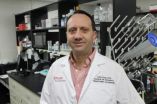(Press-News.org) A new study published in Proceedings of the National Academy of Sciences has shown for the first time that several types of aquatic algae can detect orange, green and blue light.
Land plants have receptors to detect light on the red and far red of the spectrum, which are the common wavelengths in the air. These plants sense the light to move and grow as their environment changes, for example when another plant shades them from the sun. But in the ocean, the water absorbs red wavelengths, instead reflecting colours such as blue and green. As part of the study, a team of researchers including Canadian Institute for Advanced Research (CIFAR) Senior Fellow Alexandra Worden sequenced about 20 different marine algae and found they were capable of detecting not only red light, but also many other colours. Collaborators in the lab of J. Clark Lagarias performed the biochemical analyses that established the wavelength detection.
"It's an amazing innovation of these algae to sense the whole rainbow," says Dr. Worden, who leads a microbial ecology research group at Monterey Bay Aquarium Research Institute in California. She is a member of CIFAR's Integrated Microbial Biodiversity program, which uses interdisciplinary research to study how a diversity of microbial life shapes all ecosystems. Her lab selected and grew the algae for sequencing in a collaborative effort with CIFAR Fellow Adrián Reyes-Prieto, who she first met at the Institute's program meetings. They specifically targeted diverse but largely unstudied organisms that might reveal new evolutionary insights into photosynthetic organisms. The Gordon and Betty Moore Foundation accepted sequencing nominations from Dr. Worden and provided sequencing funds in support of understanding eukaryotic algae.
"The phytoplankton in the oceans are, of course, really important to regulating our climate, and we just never knew that they were able to sense our environment in this way," she says.
Dr. Worden says her collaborators are interested in understanding the origins of photosynthetic life, in part because it played a crucial role in allowing other life forms, including humans, to exist. The research could also help with food production by teaching us ways to engineer crops so they will grow in many light conditions.
INFORMATION:
This article will be available at: http://www.pnas.org/cgi/doi/10.1073/pnas.1401871111.
Authors on this paper include Nathan C. Rockwell, Deqiang Duanmu, Shelley S. Martin, Charles Bachy, Dana C. Price, Debashish Bhattacharya, Alexandra Z. Worden, and J. Clark Lagarias.
About CIFAR
CIFAR brings together extraordinary scholars and scientists from around the world to address questions of global importance. Based in Toronto, Canada, CIFAR is a global research organization comprising nearly 400 Fellows, Scholars and Advisors from more than 100 institutions in 16 countries. CIFAR aims to generate transformative knowledge at the frontiers of understanding, to catalyze innovation and resolution of the world's major challenges, and to advance the careers of promising young researchers. Established in 1982, CIFAR partners with the Government of Canada, provincial governments, individuals, foundations, corporations and research institutions to extend our impact in the world.
For more information, or to arrange an interview with Alexandra Worden, please contact:
Lindsay Jolivet, Writer & Media Relations Specialist, CIFAR, at 416-971-4876 or lindsay.jolivet@cifar.ca
Marine algae can sense the rainbow
Study shows that algae can detect a wide spectrum of colors to adapt to their environments
2014-02-24
ELSE PRESS RELEASES FROM THIS DATE:
A paper diagnostic for cancer
2014-02-24
CAMBRIDGE, MA -- Cancer rates in developing nations have climbed sharply in recent years, and now account for 70 percent of cancer mortality worldwide. Early detection has been proven to improve outcomes, but screening approaches such as mammograms and colonoscopy, used in the developed world, are too costly to be implemented in settings with little medical infrastructure.
To address this gap, MIT engineers have developed a simple, cheap, paper test that could improve diagnosis rates and help people get treated earlier. The diagnostic, which works much like a pregnancy ...
Species conservation poised to benefit from DNA advances
2014-02-24
A biologist at the University of York is part of an international team which has shown that advanced DNA sequencing technologies can be used to accurately measure the levels of inbreeding in wild animal populations.
The research by senior author Dr Kanchon Dasmahapatra, of the Department of Biology at York, and led by Dr Joseph Hoffman, of the Department of Animal Behaviour, Bielefeld University, Germany, may help efforts to conserve rare species.
Laboratory studies show that inbreeding reduces fitness. However, studying the impact of inbreeding in wild populations has ...
Acupuncture holds promise for treating inflammatory disease
2014-02-24
When acupuncture first became popular in the western hemisphere it had its doubters. It still does. But over time, through detailed observation, scientists have produced real evidence that ancient Chinese practitioners of the medical arts were onto something.
Now new research documents a direct connection between the use of acupuncture and physical processes that could alleviate sepsis, a condition that often develops in hospital intensive care units, springs from infection and inflammation, and takes an estimated 250,000 lives in the United States every year.
"Sepsis ...
New study shows a genetic link between feeding behavior and animal dispersal
2014-02-24
New research from the University of Toronto Scarborough shows that animal dispersal is influenced by a gene associated with feeding and food search behaviours.
The study, which was carried out by UTSC Professor Mark Fitzpatrick and PhD student Allan Edelsparre, provides one of the first aimed at gaining a functional understanding of how genes can influence dispersal tendencies in nature.
Using common fruit flies (Drosophila melanogaster), the researchers observed how two different foraging types – known as sitter flies and rover flies – moved over large distances ...
Ecotourism reduces poverty near protected parks, Georgia State University research shows
2014-02-24
ATLANTA--Protected natural areas in Costa Rica reduced poverty by 16 percent in neighboring communities, mainly by encouraging ecotourism, according to new research published today in the Proceedings of the National Academy of Sciences.
Although earlier studies indicated that establishing protected areas in poor regions can lead to reductions in poverty, there was no clear understanding why or how it happens.
"Our goal was to show exactly how environmental protection can reduce poverty in poorer nations rather than exacerbate it, as many people fear," says co-author ...
AGU: Uncovering the secret world of the Plastisphere
2014-02-24
HONOLULU – Scientists are revealing how microbes living on floating pieces of plastic marine debris affect the ocean ecosystem, and the potential harm they pose to invertebrates, humans and other animals. New research being presented here today delves deeper into the largely unexplored world of the "Plastisphere" – an ecological community of microbial organisms living on ocean plastic that was first discovered last year.
When scientists initially studied the Plastisphere, they found that at least 1,000 different types of microbes thrive on these tiny plastic islands, ...
Pinwheel 'living' crystals and the origin of life
2014-02-24
ANN ARBOR—Simply making nanoparticles spin coaxes them to arrange themselves into what University of Michigan researchers call 'living rotating crystals' that could serve as a nanopump. They may also, incidentally, shed light on the origin of life itself.
The researchers refer to the crystals as 'living' because they, in a sense, take on a life of their own from very simple rules.
Sharon Glotzer, the Stuart W. Churchill Collegiate Professor of Chemical Engineering, and her team found that when they spun individual nanoparticles in a simulation—some clockwise and some ...
New study supports body shape index as predictor of mortality
2014-02-24
In 2012, Dr. Nir Krakauer, an assistant professor of civil engineering in CCNY's Grove School of Engineering, and his father, Dr. Jesse Krakauer, MD, developed a new method to quantify the risk specifically associated with abdominal obesity.
A follow-up study, published February 20 by the online journal PLOS ONE, supports their contention that the technique, known as A Body Shape Index (ABSI), is a more effective predictor of mortality than Body Mass Index (BMI), the most common measure used to define obesity.
The team analyzed data for 7,011 adults, 18+, who participated ...
Volcanoes, including Mount Hood in the US, can quickly become active
2014-02-24
New research results suggest that magma sitting 4-5 kilometers beneath the surface of Oregon's Mount Hood has been stored in near-solid conditions for thousands of years.
The time it takes to liquefy and potentially erupt, however, is surprisingly short--perhaps as little as a couple of months.
The key to an eruption, geoscientists say, is to elevate the temperature of the rock to more than 750 degrees Celsius, which can happen when hot magma from deep within the Earth's crust rises to the surface.
It was the mixing of hot liquid lava with cooler solid magma that ...
Geosphere covers Mexico, the Colorado Plateau, Russia, and offshore New Jersey
2014-02-24
Boulder, Colo., USA – New Geosphere postings cover using traditional geochemistry with novel micro-analytical techniques to understand the western Trans-Mexican Volcanic Belt; an investigation of mafic rock samples from a volcanic field near Yampa, Colorado, travertine deposits in the southeastern Colorado Plateau of New Mexico and Arizona; a study "Slushball Earth" rocks from Karelia, Russia, using field and micro-analytical techniques; and an addition to the "The History and Impact of Sea-level Change Offshore New Jersey" special issue.
Abstracts for these and other ...
LAST 30 PRESS RELEASES:
UVA’s Jundong Li wins ICDM’S 2025 Tao Li Award for data mining, machine learning
UVA’s low-power, high-performance computer power player Mircea Stan earns National Academy of Inventors fellowship
Not playing by the rules: USU researcher explores filamentous algae dynamics in rivers
Do our body clocks influence our risk of dementia?
Anthropologists offer new evidence of bipedalism in long-debated fossil discovery
Safer receipt paper from wood
Dosage-sensitive genes suggest no whole-genome duplications in ancestral angiosperm
First ancient human herpesvirus genomes document their deep history with humans
Why Some Bacteria Survive Antibiotics and How to Stop Them - New study reveals that bacteria can survive antibiotic treatment through two fundamentally different “shutdown modes”
UCLA study links scar healing to dangerous placenta condition
CHANGE-seq-BE finds off-target changes in the genome from base editors
The Journal of Nuclear Medicine Ahead-of-Print Tip Sheet: January 2, 2026
Delayed or absent first dose of measles, mumps, and rubella vaccination
Trends in US preterm birth rates by household income and race and ethnicity
Study identifies potential biomarker linked to progression and brain inflammation in multiple sclerosis
Many mothers in Norway do not show up for postnatal check-ups
Researchers want to find out why quick clay is so unstable
Superradiant spins show teamwork at the quantum scale
Cleveland Clinic Research links tumor bacteria to immunotherapy resistance in head and neck cancer
First Editorial of 2026: Resisting AI slop
Joint ground- and space-based observations reveal Saturn-mass rogue planet
Inheritable genetic variant offers protection against blood cancer risk and progression
Pigs settled Pacific islands alongside early human voyagers
A Coral reef’s daily pulse reshapes microbes in surrounding waters
EAST Tokamak experiments exceed plasma density limit, offering new approach to fusion ignition
Groundbreaking discovery reveals Africa’s oldest cremation pyre and complex ritual practices
First breathing ‘lung-on-chip’ developed using genetically identical cells
How people moved pigs across the Pacific
Interaction of climate change and human activity and its impact on plant diversity in Qinghai-Tibet plateau
From addressing uncertainty to national strategy: an interpretation of Professor Lim Siong Guan’s views
[Press-News.org] Marine algae can sense the rainbowStudy shows that algae can detect a wide spectrum of colors to adapt to their environments


